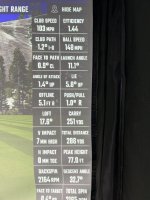Have put in quite a bit of work on my swing and trying to get everything I can dialed in. In doing that I have been getting in practice time on a GC Quad with both down the line and face on video. I finished my practice session today with a few driver swings. Took a photo of the last shot because, well I was very happy with the result.... but something jumped out at me:
Besides the fact that I had one rpm of side spin…. 5.8 upright on lie angle. Does that matter with a driver? Hoping someone with fitting experience can answer?
@xThor maybe you know?
If it helps, this is with my Core Paradym 10.5* head set at n/+1 with the weight almost completely in fade setting.
Also, how the heck do I generate more spin (besides more club head speed and hitting it lower on the face…)? 2200 is fun when I hit the middle of the face…. Not so great when the toe comes into play…

Besides the fact that I had one rpm of side spin…. 5.8 upright on lie angle. Does that matter with a driver? Hoping someone with fitting experience can answer?
@xThor maybe you know?
If it helps, this is with my Core Paradym 10.5* head set at n/+1 with the weight almost completely in fade setting.
Also, how the heck do I generate more spin (besides more club head speed and hitting it lower on the face…)? 2200 is fun when I hit the middle of the face…. Not so great when the toe comes into play…












